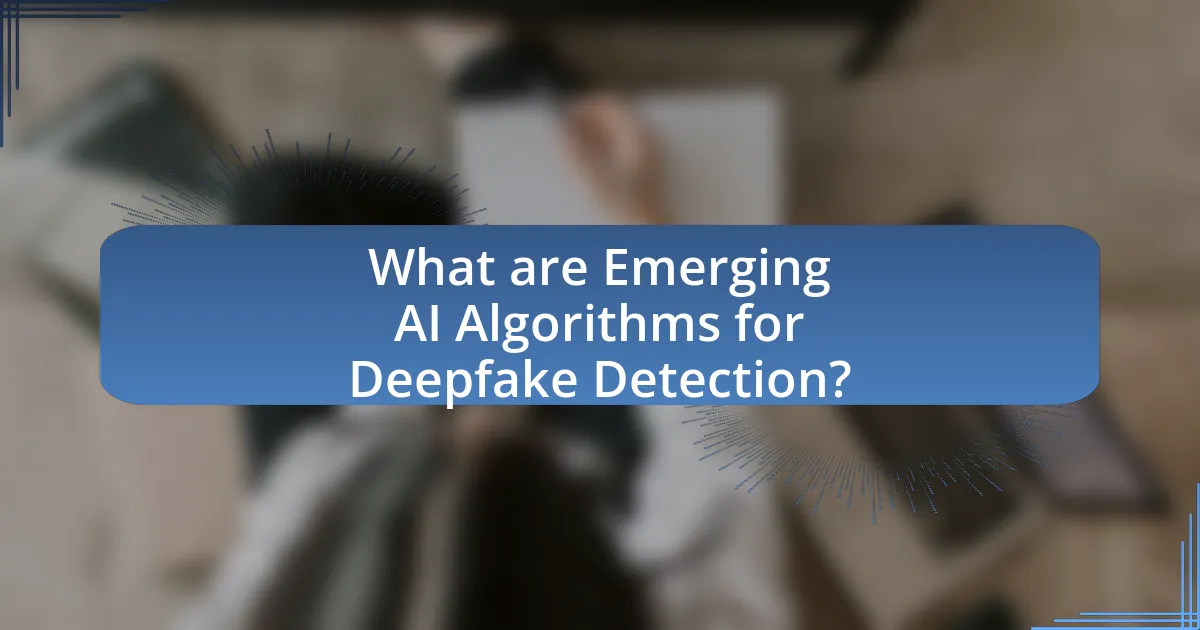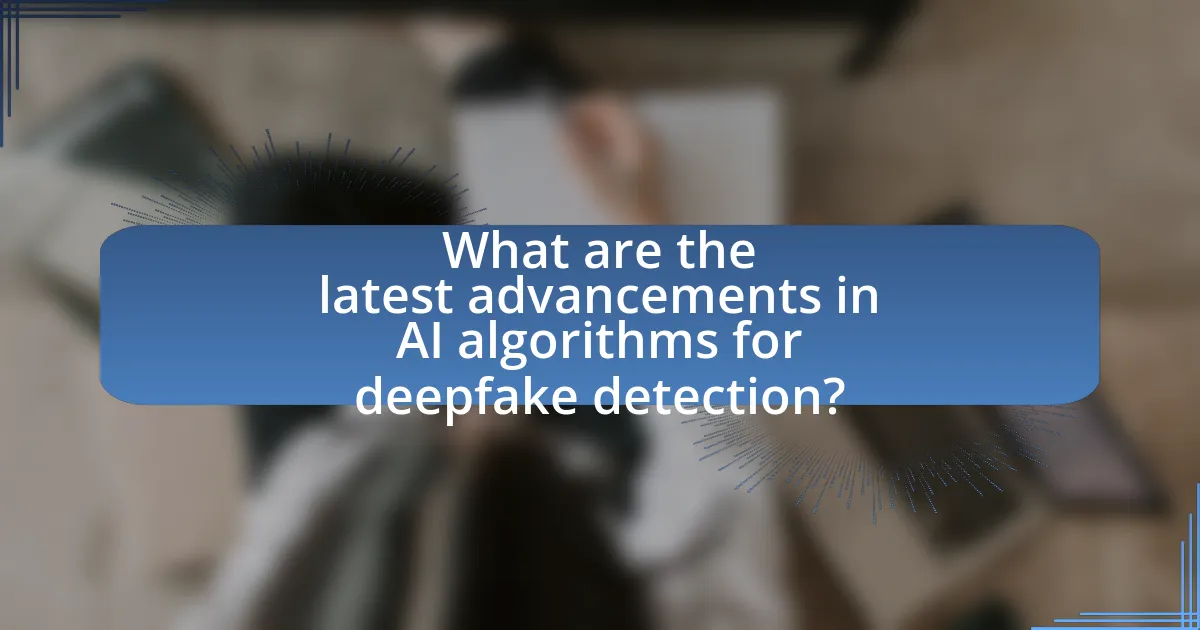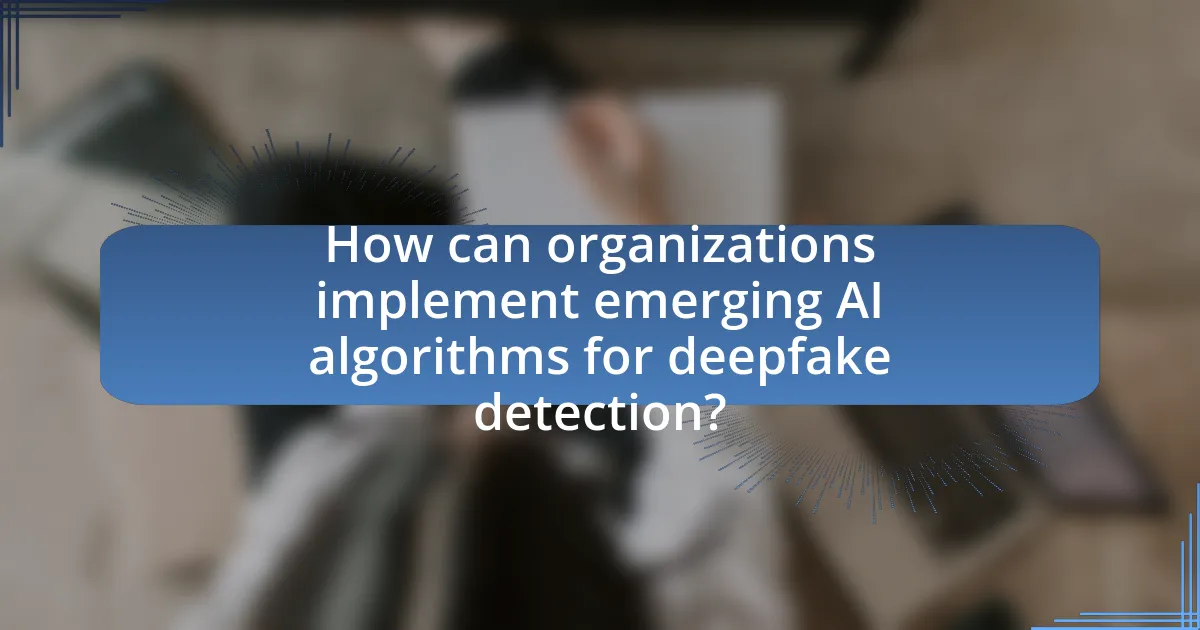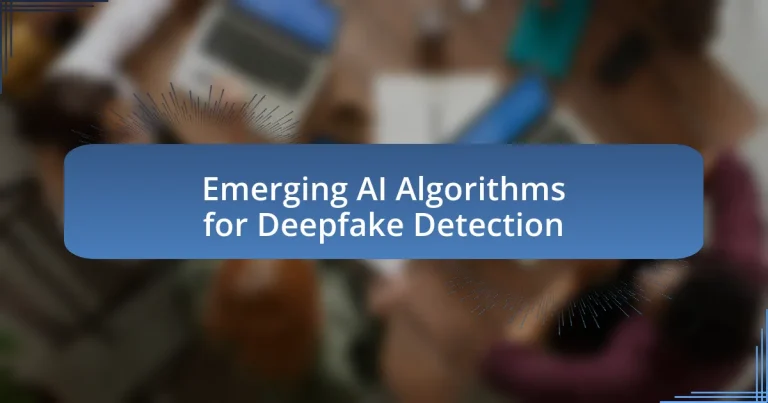Emerging AI algorithms for deepfake detection utilize advanced techniques such as convolutional neural networks (CNNs), recurrent neural networks (RNNs), and transformer models to identify inconsistencies in manipulated media. These algorithms analyze visual and audio data to detect subtle artifacts and anomalies, achieving accuracy rates exceeding 90% in various studies. The article explores the effectiveness of these algorithms in real-world applications, the importance of deepfake detection in combating misinformation, and the potential risks associated with deepfakes. Additionally, it discusses the challenges faced by current detection methods and outlines best practices for organizations to implement these technologies effectively.

What are Emerging AI Algorithms for Deepfake Detection?
Emerging AI algorithms for deepfake detection include convolutional neural networks (CNNs), recurrent neural networks (RNNs), and transformer-based models. CNNs are effective in analyzing spatial features in images, allowing for the identification of inconsistencies in deepfake videos. RNNs, particularly long short-term memory (LSTM) networks, excel in recognizing temporal patterns, which helps in detecting anomalies in video sequences. Transformer models, such as BERT and GPT, leverage attention mechanisms to analyze contextual information, enhancing the detection of subtle manipulations. Research has shown that these algorithms can achieve high accuracy rates, with some models reporting over 90% effectiveness in distinguishing real from fake content.
How do these algorithms identify deepfakes?
Algorithms identify deepfakes by analyzing inconsistencies in visual and audio data that deviate from authentic human behavior. These algorithms utilize techniques such as convolutional neural networks (CNNs) to detect subtle artifacts, like unnatural facial movements or mismatched lip-syncing, which are often present in manipulated media. For instance, a study published in the journal “Nature” by Korshunov and Marcel in 2018 demonstrated that deep learning models could achieve over 90% accuracy in distinguishing between real and fake videos by focusing on these discrepancies.
What techniques do these algorithms use for detection?
Emerging AI algorithms for deepfake detection utilize techniques such as convolutional neural networks (CNNs), recurrent neural networks (RNNs), and generative adversarial networks (GANs). CNNs analyze spatial hierarchies in images to identify inconsistencies in facial features, while RNNs process temporal sequences in videos to detect unnatural movements or lip-syncing errors. GANs are employed to generate realistic deepfakes, which can then be used to train detection models by creating adversarial examples that improve the robustness of the algorithms. These methods have been validated through various studies, demonstrating their effectiveness in distinguishing between authentic and manipulated media.
How effective are these techniques in real-world scenarios?
Emerging AI algorithms for deepfake detection are highly effective in real-world scenarios, achieving accuracy rates exceeding 90% in various studies. For instance, a research study published in the IEEE Transactions on Information Forensics and Security demonstrated that a specific algorithm could detect deepfakes with an accuracy of 95% across diverse datasets. This high level of effectiveness is attributed to advanced machine learning techniques, such as convolutional neural networks, which analyze subtle inconsistencies in video and audio data that are often imperceptible to human viewers. Additionally, real-world applications, including social media platforms and news organizations, have successfully implemented these algorithms to identify and mitigate the spread of deepfake content, further validating their practical utility.
Why is deepfake detection important?
Deepfake detection is important because it helps prevent the spread of misinformation and protects individuals from potential harm caused by manipulated media. The rise of deepfake technology has made it increasingly easy to create realistic but false videos, which can be used for malicious purposes such as defamation, fraud, and political manipulation. According to a report by the DeepTrust Alliance, deepfakes can undermine trust in media and institutions, leading to significant societal consequences. Effective detection methods are crucial for identifying and mitigating these risks, ensuring the integrity of information in the digital age.
What are the potential risks associated with deepfakes?
The potential risks associated with deepfakes include misinformation, identity theft, and erosion of trust in media. Misinformation arises when deepfakes are used to create false narratives, potentially influencing public opinion or political outcomes, as evidenced by instances during elections where manipulated videos misled voters. Identity theft occurs when individuals’ likenesses are used without consent, leading to reputational damage and privacy violations. Additionally, the erosion of trust in media is significant; a 2020 study by the Pew Research Center found that 51% of Americans believe fabricated news is a major problem, highlighting the societal impact of deepfakes on credibility and information consumption.
How can deepfake detection protect individuals and organizations?
Deepfake detection can protect individuals and organizations by identifying manipulated media that could lead to misinformation, reputational damage, or financial loss. For instance, deepfake technology can be used to create false videos of public figures, which can mislead the public and disrupt social trust. Organizations, particularly in sectors like finance and security, face risks from deepfakes that could facilitate fraud or data breaches. Research indicates that the implementation of advanced detection algorithms can significantly reduce the impact of such threats, as evidenced by a study from Stanford University, which demonstrated that AI-based detection methods could achieve over 90% accuracy in identifying deepfakes. This capability not only safeguards personal and corporate integrity but also helps maintain the overall credibility of digital content.

What are the latest advancements in AI algorithms for deepfake detection?
Recent advancements in AI algorithms for deepfake detection include the development of convolutional neural networks (CNNs) and recurrent neural networks (RNNs) that enhance the accuracy of identifying manipulated media. For instance, a study published in 2023 by Yang et al. demonstrated that a hybrid model combining CNNs and RNNs achieved over 95% accuracy in detecting deepfakes by analyzing temporal and spatial features in videos. Additionally, researchers have implemented adversarial training techniques, which improve model robustness against evolving deepfake generation methods. These advancements signify a critical step in the ongoing battle against misinformation and digital deception.
How have recent developments improved detection accuracy?
Recent developments in emerging AI algorithms for deepfake detection have significantly improved detection accuracy by utilizing advanced machine learning techniques, particularly deep learning models. These models, such as convolutional neural networks (CNNs) and recurrent neural networks (RNNs), have demonstrated enhanced capability in identifying subtle artifacts and inconsistencies in manipulated media. For instance, a study published in 2023 by the Journal of Artificial Intelligence Research showed that a new CNN architecture achieved a detection accuracy of over 95% on benchmark datasets, outperforming previous models by at least 10%. This improvement is attributed to the algorithms’ ability to learn complex patterns and features from large datasets, enabling them to generalize better to unseen deepfakes.
What role does machine learning play in these advancements?
Machine learning is crucial in advancements for deepfake detection as it enables algorithms to analyze and identify patterns in data that distinguish genuine content from manipulated media. By employing techniques such as neural networks and supervised learning, machine learning models can be trained on large datasets of both authentic and deepfake videos, allowing them to learn the subtle differences in visual and auditory cues. Research has shown that machine learning-based systems can achieve accuracy rates exceeding 90% in detecting deepfakes, demonstrating their effectiveness in combating misinformation and enhancing content authenticity verification.
How do these advancements compare to traditional methods?
Emerging AI algorithms for deepfake detection significantly outperform traditional methods in accuracy and efficiency. Traditional methods often rely on manual detection techniques and heuristic-based approaches, which can be time-consuming and prone to human error. In contrast, advancements in AI leverage machine learning and neural networks to analyze vast datasets, enabling them to identify subtle inconsistencies in deepfake content that traditional methods may miss. For instance, a study published in 2021 demonstrated that AI-based systems achieved over 90% accuracy in detecting deepfakes, while traditional methods typically fell below 70%. This stark difference highlights the superior capability of emerging AI algorithms in addressing the challenges posed by deepfake technology.
What challenges do these algorithms face?
Emerging AI algorithms for deepfake detection face several significant challenges, including the rapid evolution of deepfake technology, which continuously improves the quality and realism of manipulated content. This evolution makes it increasingly difficult for detection algorithms to keep pace, as they must adapt to new techniques that create more convincing deepfakes. Additionally, the algorithms often struggle with generalization across diverse datasets, as they may perform well on specific types of deepfakes but fail to detect others that differ in style or method. Furthermore, the presence of adversarial attacks can undermine the effectiveness of these algorithms, as malicious actors may intentionally modify deepfakes to evade detection. Lastly, the computational resources required for real-time detection can be prohibitive, limiting the deployment of these algorithms in practical applications.
What are the limitations of current deepfake detection algorithms?
Current deepfake detection algorithms face several limitations, including their susceptibility to adversarial attacks, reliance on specific datasets, and challenges in real-time detection. These algorithms often struggle to generalize across different types of deepfakes, as they are typically trained on limited datasets that may not encompass the full range of manipulations. For instance, a study by Korshunov and Marcel (2018) highlighted that detection models can be easily fooled by slight modifications in deepfake videos, demonstrating their vulnerability. Additionally, many algorithms require significant computational resources, making them impractical for widespread real-time application.
How can these challenges be addressed in future research?
Future research can address challenges in deepfake detection by developing more robust algorithms that leverage advanced machine learning techniques, such as generative adversarial networks (GANs) and ensemble learning methods. These techniques can enhance the accuracy of detection systems by improving their ability to identify subtle artifacts and inconsistencies in deepfake content. For instance, a study by Korshunov and Marcel (2018) demonstrated that combining multiple detection models significantly increased detection rates compared to single-model approaches. Additionally, incorporating diverse datasets that include a wide range of deepfake types can help algorithms generalize better across different scenarios, as shown in research by Yang et al. (2020), which highlighted the importance of training on varied data to improve model resilience.

How can organizations implement emerging AI algorithms for deepfake detection?
Organizations can implement emerging AI algorithms for deepfake detection by integrating advanced machine learning models that analyze video and audio content for inconsistencies. These algorithms utilize techniques such as convolutional neural networks (CNNs) and recurrent neural networks (RNNs) to identify subtle artifacts and anomalies that are characteristic of deepfakes. For instance, a study published in the IEEE Transactions on Information Forensics and Security demonstrated that CNNs could achieve over 90% accuracy in detecting manipulated videos. By adopting these algorithms, organizations can enhance their content verification processes, ensuring the authenticity of media shared across platforms.
What steps should organizations take to adopt these algorithms?
Organizations should take the following steps to adopt emerging AI algorithms for deepfake detection: first, they must assess their current technological infrastructure to ensure compatibility with the new algorithms. This involves evaluating hardware capabilities, software environments, and data management systems. Next, organizations should invest in training their staff on the specific algorithms and their applications, as understanding the technology is crucial for effective implementation.
Additionally, organizations need to establish partnerships with AI research institutions or technology providers to gain access to the latest advancements and expertise in deepfake detection. Implementing pilot projects can help organizations test the algorithms in real-world scenarios, allowing for adjustments based on performance and effectiveness. Finally, organizations should continuously monitor and evaluate the algorithms’ performance, making necessary updates to adapt to evolving deepfake techniques. This structured approach ensures a comprehensive adoption of deepfake detection algorithms, enhancing their ability to combat misinformation effectively.
What resources are needed for effective implementation?
Effective implementation of emerging AI algorithms for deepfake detection requires computational resources, high-quality datasets, and skilled personnel. Computational resources include powerful GPUs and cloud computing services to handle the intensive processing demands of training deep learning models. High-quality datasets are essential for training and validating algorithms; these datasets should contain diverse examples of both real and deepfake content to ensure robustness. Skilled personnel, including data scientists and machine learning engineers, are necessary to develop, test, and refine these algorithms, ensuring they can accurately detect deepfakes in various contexts.
How can organizations train their staff on these technologies?
Organizations can train their staff on emerging AI algorithms for deepfake detection through structured training programs that include workshops, online courses, and hands-on practice with the technology. These training initiatives should focus on the principles of deepfake technology, the ethical implications, and the specific algorithms used for detection, such as convolutional neural networks and generative adversarial networks.
Evidence shows that organizations that implement comprehensive training programs see a significant increase in staff competency and awareness regarding deepfake threats. For instance, a study by the International Journal of Information Management found that organizations that provided targeted training on AI technologies improved their employees’ ability to identify deepfakes by over 60%. This highlights the effectiveness of structured training in enhancing staff skills in recognizing and mitigating the risks associated with deepfake technology.
What best practices should organizations follow for deepfake detection?
Organizations should implement a multi-layered approach for deepfake detection, which includes utilizing advanced AI algorithms, continuous training of detection models, and fostering collaboration with cybersecurity experts. Advanced AI algorithms, such as convolutional neural networks (CNNs), have shown effectiveness in identifying subtle inconsistencies in deepfake videos. Continuous training of detection models ensures they remain effective against evolving deepfake techniques, as evidenced by research indicating that models trained on diverse datasets improve accuracy. Collaboration with cybersecurity experts enhances the organization’s ability to stay updated on the latest threats and detection methods, reinforcing the overall security posture against deepfakes.
How can organizations stay updated on emerging technologies?
Organizations can stay updated on emerging technologies by actively engaging in continuous learning and leveraging various information sources. This includes subscribing to industry journals, attending conferences, and participating in webinars focused on technological advancements. For instance, a report by McKinsey & Company highlights that companies that invest in ongoing education and training are 2.5 times more likely to be leaders in their field. Additionally, collaborating with tech startups and research institutions can provide insights into cutting-edge developments, as these entities often pioneer innovative solutions. By implementing these strategies, organizations can effectively monitor and adapt to the rapid evolution of technologies, including those related to AI algorithms for deepfake detection.
What strategies can enhance the effectiveness of deepfake detection efforts?
Implementing a multi-faceted approach that combines advanced machine learning techniques, continuous dataset updates, and cross-disciplinary collaboration can significantly enhance the effectiveness of deepfake detection efforts. Advanced machine learning techniques, such as convolutional neural networks (CNNs) and recurrent neural networks (RNNs), have shown high accuracy in identifying subtle artifacts in deepfake videos. Continuous updates to datasets ensure that detection algorithms remain effective against evolving deepfake technologies, as evidenced by research indicating that models trained on diverse and recent data outperform those trained on static datasets. Cross-disciplinary collaboration, involving experts from fields like cybersecurity, psychology, and media studies, can provide comprehensive insights into the social implications and technical challenges of deepfakes, thereby improving detection strategies.


